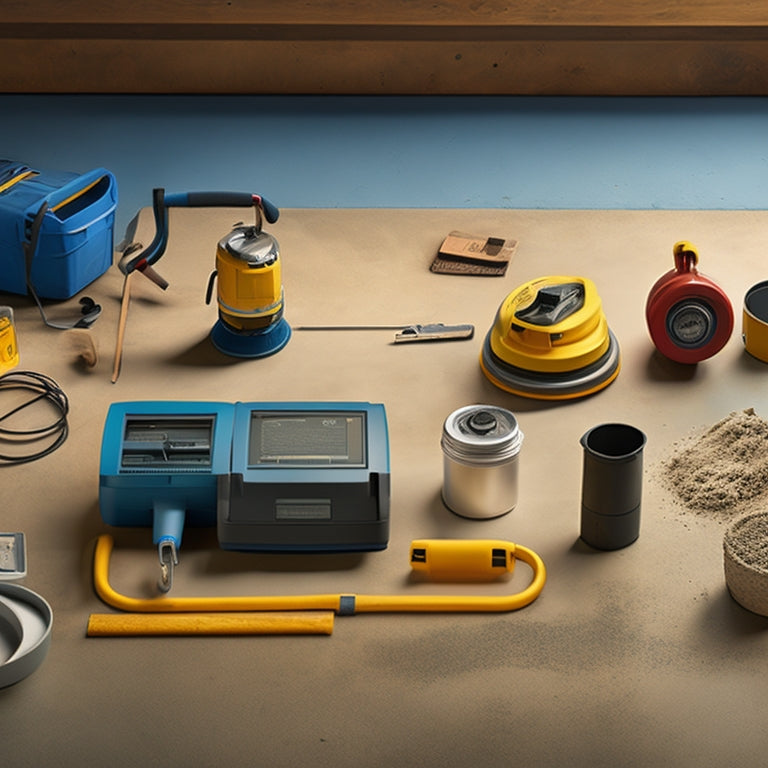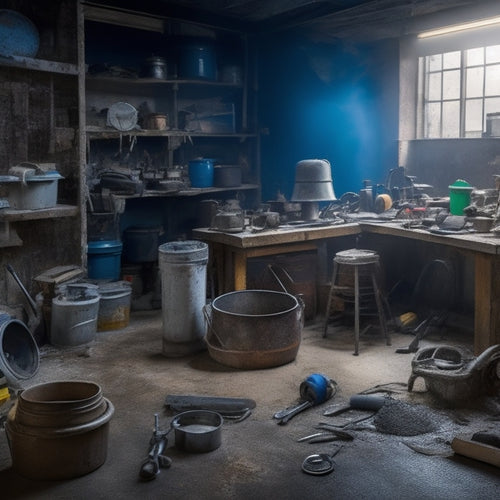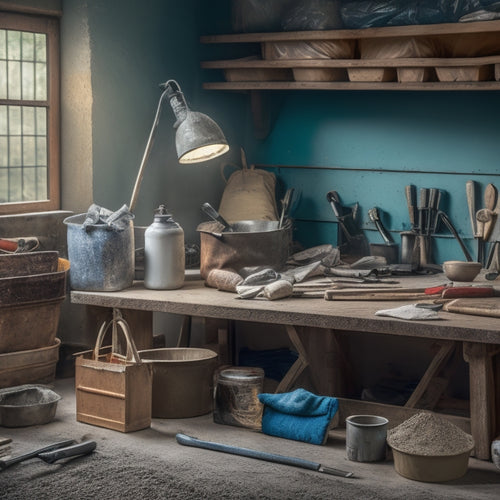
Durable Tools for Concrete Resurfacing Success
Share
When tackling concrete resurfacing projects, you need durable tools that can withstand the demands of the job. Invest in high-quality tools from trusted brands like Makita, Bosch, and DeWalt, known for their durability and performance. Look for tools made with high-carbon steel and diamond-coated blades, and prioritize sturdy design and secure attachments. Assess the tool's ergonomic handle design, weight distribution, and balance to reduce fatigue and improve control. Regularly inspect and maintain your tools to guarantee peak performance and safety. By choosing the right tools and following best practices, you'll be well on your way to achieving concrete resurfacing success - and there's more to explore to guarantee your projects reach their full potential.
Key Takeaways
• Choose high-quality tools from reputable brands like Makita, Bosch, and DeWalt for durability and performance in concrete resurfacing.
• Select tools with high-carbon steel and diamond-coated blades for optimal material removal and tool longevity.
• Regular maintenance practices, including cleaning, lubricating, and proper storage, are crucial for tool durability and safety.
• Ergonomic handle design, durable materials, and adjustable features reduce fatigue, improve control, and enhance overall user experience.
• Regularly inspect and test tools under real-world conditions to ensure they meet performance metrics and can withstand job site demands.
Selecting the Right Concrete Tools
When resurfacing concrete, you need to equip yourself with the right tools to guarantee a successful and efficient project, as using the wrong ones can lead to subpar results and wasted time. You'll require tools that can withstand the demands of concrete resurfacing, which involves grinding, polishing, and finishing concrete surfaces.
To ensure ideal performance, it's essential to choose tools from important brands that prioritize durability and quality. Look for brands that offer rugged and reliable products, such as Makita, Bosch, and DeWalt. These brands have a reputation for producing high-performance tools that can withstand the rigors of concrete resurfacing.
Proper tool maintenance is also fundamental to extend the lifespan of your tools and prevent premature wear. Regularly clean and lubricate your tools, and store them in a dry, secure location. Additionally, follow tool maintenance tips, such as sharpening diamond blades and replacing worn-out parts, to maintain peak performance.
Evaluating Tool Material and Build
When evaluating tool material and build for concrete resurfacing, you'll want to contemplate three key factors.
You'll need to assess the tool's material strength to guarantee it can withstand the rigors of the job.
Tool Material Strength
Evaluating the tool material and build is essential, as it directly impacts the tool's ability to withstand the rigors of concrete resurfacing and guarantees you get the desired results.
You need to verify the tool's material composition can withstand the abrasive nature of concrete and the intense forces involved in resurfacing. A tool made from high-quality, durable materials will last longer and perform better, resulting in increased tool longevity.
When selecting a tool, look for materials with high strength-to-weight ratios, such as high-carbon steel or diamond-coated blades. These materials can withstand the intense forces and abrasive nature of concrete, verifying your tool remains effective throughout the resurfacing process.
Additionally, consider the tool's build quality, including its overall design and construction. A well-built tool with a sturdy frame and secure attachments will be better equipped to handle the demands of concrete resurfacing.
Concrete Bonding Ability
As you examine a tool's material strength, you'll also want to assess its concrete bonding ability. This ability relies on the tool's surface texture and material properties to create a strong bond between the new overlay and the existing concrete.
This bonding ability is critical to guaranteeing a durable and long-lasting resurfacing job. A tool with a rough, textured surface can provide a better mechanical bond with the concrete, while its material properties can facilitate a strong chemical bond.
You should also consider the tool's compatibility with bonding agents, which can enhance the bonding process. Additionally, proper surface preparation is essential to achieving a strong bond. This includes cleaning the surface, removing any contaminants, and creating a rough texture for the new overlay to adhere to.
Durability in Harsh
You'll need to assess the tool's material and build to affirm it can withstand the harsh conditions of concrete resurfacing, where heavy use and exposure to abrasive materials are commonplace. This evaluation is critical, as it directly impacts the tool's durability and performance in harsh environments.
When selecting a tool, look for materials that demonstrate exceptional weather resistance, such as stainless steel or high-carbon steel. These materials are more resistant to corrosion and can withstand the rigors of concrete resurfacing.
Additionally, examine the tool's build quality, paying attention to the construction and finish. A well-built tool with a durable finish can resist wear and tear, affirming it remains effective even in the most challenging conditions.
Consider the tool's ergonomic design, as a comfortable grip and balanced weight distribution can reduce fatigue and improve performance. By carefully evaluating the tool's material and build, you can affirm it has the durability and performance required to succeed in concrete resurfacing.
Assessing Ergonomic Handle Design
When resurfacing concrete, your hands and wrists are subjected to repetitive strain and vibration, making a handle's ergonomic design essential for reducing fatigue and improving overall tool control. A well-designed handle can make all the difference in your performance and comfort during extended periods of use.
To assess the ergonomic design of a handle, consider the following factors:
| Handle Feature | Desirable Characteristics | Benefits |
|---|---|---|
| Grip Texture | Coarse, non-slip | Enhanced grip, reduced fatigue |
| Handle Material | Durable, shock-absorbing | Reduced vibration, improved comfort |
| Handle Shape | Contoured, ergonomic | Improved grip, reduced strain |
| Handle Size | Adjustable, comfortable | Accommodates various hand sizes, reduces fatigue |
| Handle Angle | Adjustable, ergonomic | Reduces strain, improves control |
Considering Weight and Balance Factors
Properly balancing the weight of your tools is essential, since an uneven distribution can exacerbate fatigue and compromise your control during concrete resurfacing operations. As you prepare for your project, consider the weight distribution of your tools and how it will impact your performance. A well-balanced tool enables you to work efficiently, maintain precision, and reduce the risk of accidents.
To achieve ideal balance, you should employ balance techniques that take into account the tool's design and your personal comfort. For instance, you can adjust the tool's handle to fit your grip, ensuring that the weight is evenly distributed between your hands.
Additionally, look for tools with ergonomic design features, such as counterbalanced handles or adjustable grips, which can help redistribute weight and reduce fatigue.
Inspecting Blade Quality and Sharpness
With your tools balanced and comfortable to handle, inspect the blade's quality and sharpness to confirm it can effectively penetrate and remove old concrete. A dull or damaged blade can lead to inefficient resurfacing, increased fatigue, and decreased productivity. Regularly inspect your blade for signs of wear, such as chipping, cracking, or excessive rust.
| Blade Condition | Action |
|---|---|
| Dull or rusty | Sharpen or replace the blade to maintain peak performance |
| Chipped or cracked | Inspect for structural integrity; replace if necessary |
| Excessive wear | Consider blade maintenance tips, such as cleaning and lubricating, to extend lifespan |
To maintain peak performance, incorporate sharpening techniques into your routine. Use a diamond stone or sharpening wheel to hone the blade's edge, and always follow the manufacturer's guidelines for maintenance and repair. By prioritizing blade quality and sharpness, you'll confirm a successful concrete resurfacing project and extend the lifespan of your tools.
Reviewing Safety Features and Guards
Reviewing your tools' safety features and guards is vital to preventing accidents and guaranteeing a successful concrete resurfacing project. You can't afford to overlook this important step, as it directly impacts your well-being and the project's outcome.
Familiarize yourself with the safety regulations governing your industry and verify your tools comply with them. Check for features like safety switches, emergency stops, and protective casings that prevent accidental start-ups and electrical shocks.
Don't forget to inspect the guards that protect you from moving parts, such as blades and gears. Make sure they're securely attached and functioning as intended.
It's also essential to wear personal protective equipment (PPE) like gloves, safety glasses, and respirators when operating power tools. Always follow the manufacturer's guidelines for tool operation, maintenance, and repair.
Examining Tool Versatility and Adaptability
You'll get the most out of your tools and streamline your concrete resurfacing project by choosing equipment that can adapt to various tasks and surfaces. This versatility is essential, as it allows you to tackle different aspects of the project without needing to switch tools constantly.
Look for tools that can be easily adjusted or configured to suit different applications. For instance, a grinder that can switch between aggressive and fine grinding modes can be a valuable asset.
Tool innovation has led to the development of more versatile equipment, and manufacturers are now designing tools with adaptability in mind. User feedback has played a significant role in shaping these innovations, with contractors and operators providing valuable insights into what they need from their tools.
Testing Tool Performance and Durability
Evaluating tool performance and durability under real-world conditions is essential to guaranteeing that your concrete resurfacing equipment can withstand the demands of the job site. You need to put your tools to the test to guarantee they can handle the rigors of daily use. This involves establishing clear performance metrics and testing standards to assess their durability.
| Performance Metric | Testing Standard | Acceptable Range |
|---|---|---|
| Tool lifespan | Hours of continuous operation | ≥ 500 hours |
| Material removal rate | Square feet per hour | ≥ 100 sqft/hr |
| Vibration level | Decibels | ≤ 90 dB |
Frequently Asked Questions
Can I Use Concrete Resurfacing Tools for Other Construction Tasks?
You're wondering if concrete resurfacing tools can be used for other construction tasks.
The answer is yes, many of these tools have versatile applications beyond resurfacing.
With tool compatibility in mind, you can adapt edgers, grinders, and trowels for tasks like floor preparation, epoxy coating, and even tile installation.
How Often Should I Clean and Maintain My Concrete Tools?
You're like a surgeon with your tools; precision is key.
When it comes to concrete tools, regular cleaning and maintenance are essential to prolong their lifespan. You should clean your tools after every use, using techniques like wire brushing and pressure washing to remove debris.
Schedule regular deep cleaning sessions, ideally every 1-2 weeks, to prevent rust and corrosion. By doing so, you'll guarantee your tools remain in top condition, ready to tackle any concrete resurfacing project that comes your way.
Are There Any Certifications for Concrete Resurfacing Tool Operators?
You're looking to take your concrete resurfacing skills to the next level.
Yes, there are certification programs available for tool operators like you. These programs focus on operator training, ensuring you're proficient in equipment operation, safety protocols, and best practices.
By getting certified, you'll demonstrate your expertise and commitment to delivering high-quality results, giving you a competitive edge in the industry.
Research and enroll in a reputable program to elevate your career.
Can I Rent or Lease Concrete Resurfacing Tools Instead of Buying?
Rather than breaking the bank, you're wise to contemplate alternatives.
Can you really justify the hefty upfront cost of buying concrete resurfacing tools?
Luckily, you have rental options that can save your wallet from taking a hit.
Many equipment suppliers offer tool availability for lease or rent, allowing you to access high-quality gear without the long-term commitment.
This flexible approach guarantees you get the job done without sacrificing quality or financial stability.
What Is the Average Lifespan of a Concrete Resurfacing Tool?
You're wondering about the average lifespan of a concrete resurfacing tool.
It largely depends on tool durability, usage frequency, and the resurfacing techniques you employ.
On average, high-quality tools can last anywhere from 5 to 15 years, with some lasting up to 20 years or more with proper maintenance.
Factors like material quality, storage, and handling also impact a tool's lifespan.
Conclusion
As you wrap up your concrete resurfacing project, remember that the right tools can make all the difference.
In fact, did you know that a single dull blade can increase project time by up to 30%?
By investing in durable, high-quality tools, you'll not only save time but also guarantee a professional-grade finish.
By following these guidelines, you'll be well on your way to selecting the perfect tools for your next concrete resurfacing project.
Related Posts
-

7 Tools to Fix Damaged Concrete Floors
You're about to tackle that damaged concrete floor, and the right tools are essential for a successful repair. Start ...
-

10 Must-Have Tools for Small Concrete Projects
When tackling small concrete projects, you'll need a range of essential tools to achieve professional-grade results. ...
-

Top Mixing Tools for DIY Concrete Block Laying
When it comes to DIY concrete block laying, the right mixing tools are vital for a strong and durable structure. You'...


